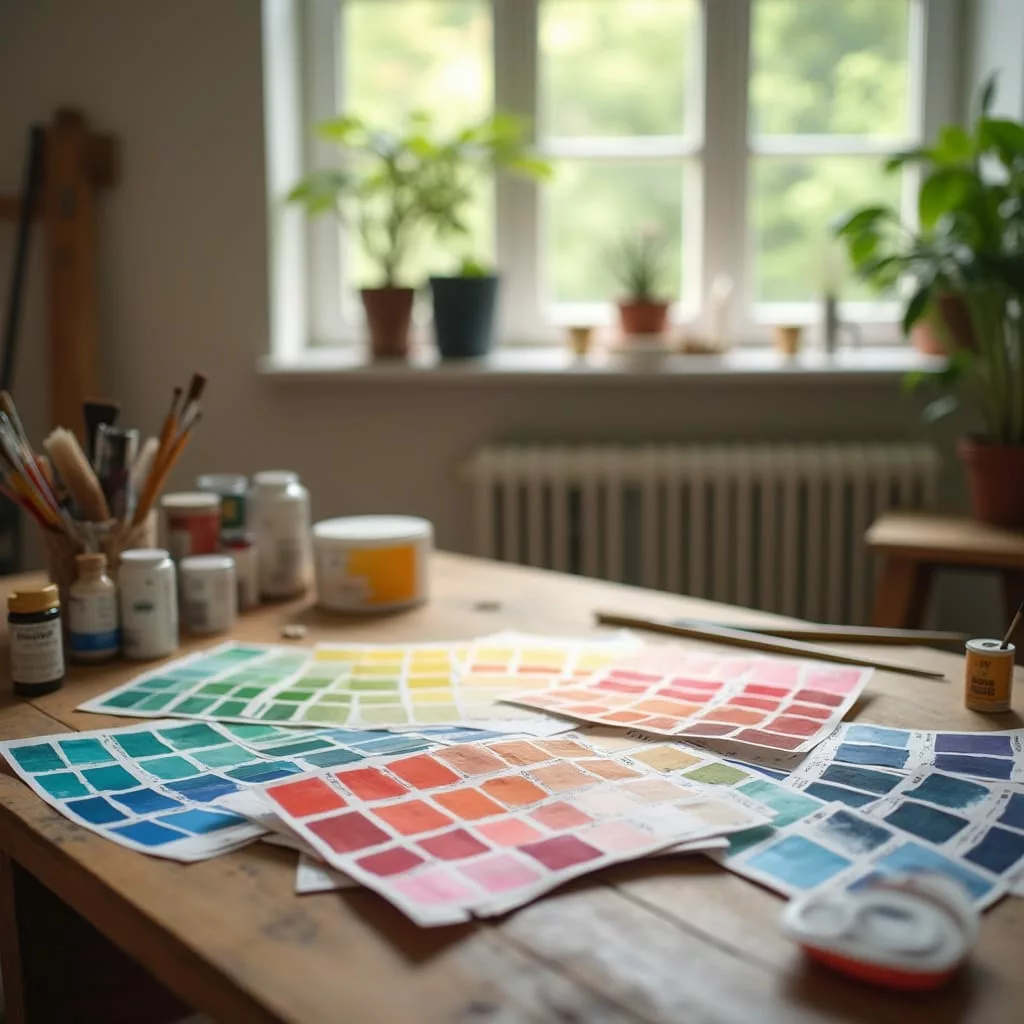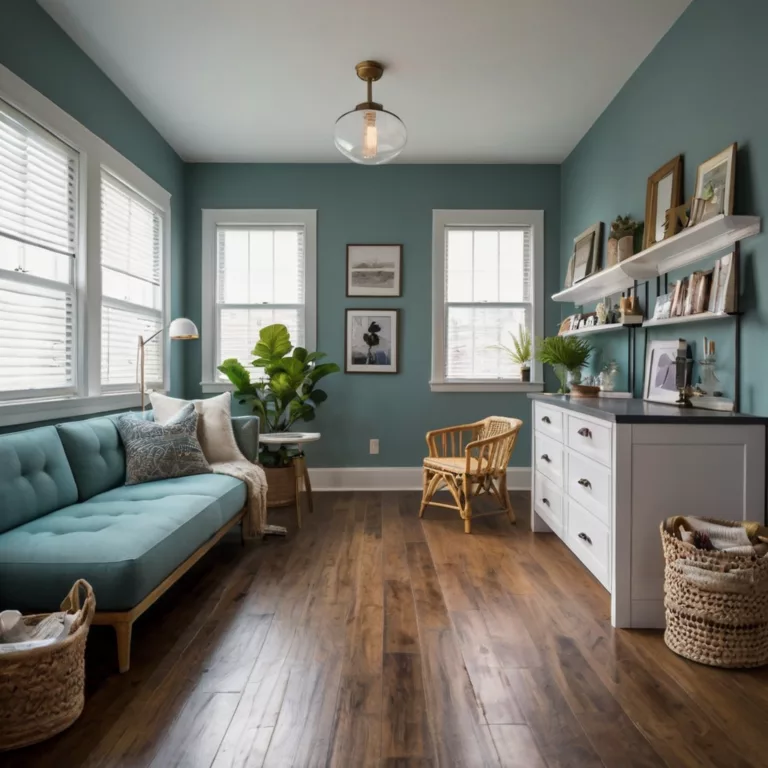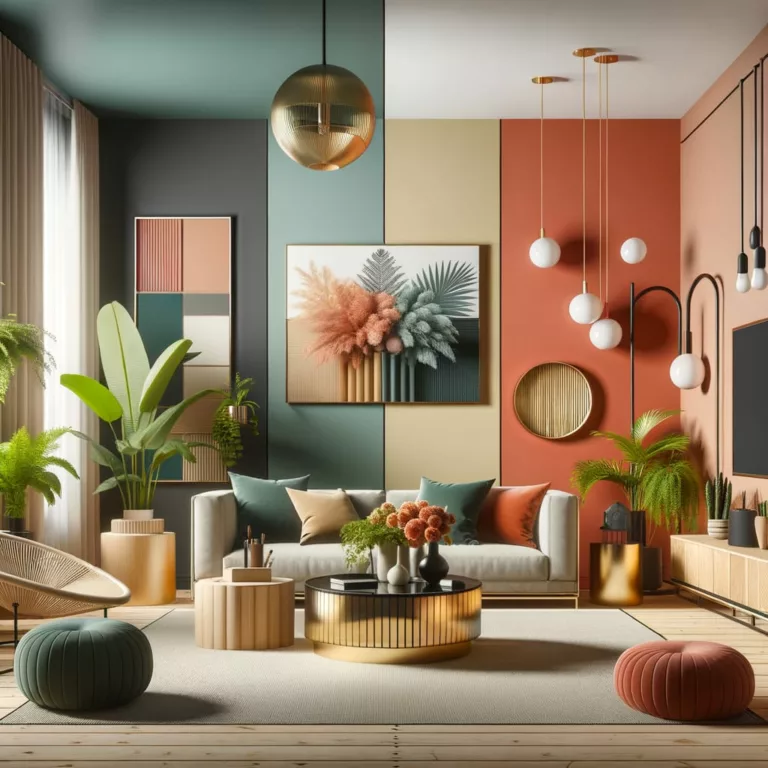What to Do If Your Paint Color Looks Different Than Expected:
Introduction
You’ve spent weeks poring over paint swatches, testing samples, and finally selected the perfect color for your space. The painters finish their work or perhaps you’ve completed the DIY project yourself and suddenly, your heart sinks. The color on your walls looks nothing like what you expected. It’s too dark, too light, too blue, too yellow, or somehow just not right. This disappointing scenario plays out in homes across the world every day, leaving homeowners frustrated and uncertain about how to proceed.
The disparity between expected and actual paint colors is not only common but also one of the most reported issues in interior design and home improvement. Many factors can influence how paint appears once applied to your walls, from lighting conditions to the surrounding environment. Understanding these variables and knowing how to address them can save you time, money, and considerable stress.
This comprehensive guide explores why paint colors often appear different than expected and provides actionable strategies to fix the issue or prevent it from happening in the first place. Whether you’re a homeowner tackling your first painting project, a seasoned DIY enthusiast, or a professional designer advising clients, this guide will equip you with the knowledge and tools to ensure your paint colors achieve your desired aesthetic.
Part 1: Understanding Why Paint Colors Look Different Than Expected
The Science of Color Perception
To understand why paint colors can look different than expected, it’s essential to grasp the basics of color perception. Color is not an inherent property of objects but rather how our brains interpret light wavelengths reflected off surfaces. Several factors influence this interpretation:
Light and Wavelengths: Different light sources emit varying wavelengths across the color spectrum. Natural daylight contains all wavelengths, while artificial lights often emphasize particular parts of the spectrum.
Surface Reflection: When light hits a painted surface, some wavelengths are absorbed while others are reflected. The reflected wavelengths determine the color we perceive.
Human Perception: Our eyes contain receptors (cones) that detect red, green, and blue light. The brain interprets signals from these receptors to perceive color. However, individual perception can vary based on genetics, age, and even emotional state.
Common Factors Affecting Paint Color Appearance
1. Lighting Conditions
Natural Light: The intensity and direction of sunlight significantly impact color perception. North-facing rooms receive cooler, more consistent light, while south-facing rooms get warmer, more intense illumination throughout the day. East-facing spaces experience bright morning light, and west-facing areas get warm afternoon light.
Artificial Light: Different types of artificial lighting dramatically affect color perception:
- Incandescent bulbs cast a warm, yellowish glow
- Fluorescent lighting often produces a cool, bluish tint
- LED lights vary widely but can emphasize either warm or cool tones
- Halogen lighting provides a whiter, more natural-looking light
Time of Day: As natural light changes throughout the day, your paint color will appear to shift. A pale blue might look vibrant in morning light but muted or grayer by evening.
2. Surface and Application Factors
Wall Texture: Textured walls create small shadows that can darken the overall appearance of a paint color. Smooth walls reflect more light, making colors appear brighter.
Previous Wall Color: Inadequate priming over a dramatically different color can allow the underlying hue to influence the new color, especially with lighter paints.
Paint Application Method: Brushes, rollers, and sprayers apply paint differently, affecting the texture and how light reflects off the surface.
Paint Coverage: Insufficient coverage or uneven application can create patches that appear lighter or darker.
3. Color Context and Environment
Adjacent Colors: Colors appear different depending on what surrounds them—a phenomenon known as simultaneous contrast. For example, a neutral gray may appear cooler next to warm colors and warmer next to cool colors.
Furnishings and Décor: The colors of furniture, flooring, artwork, and textiles in a room interact with wall colors, potentially shifting how they’re perceived.
Room Size and Architecture: Paint colors can appear more intense in small spaces and less saturated in large ones. Architectural features like moldings, alcoves, and ceiling height affect how light interacts with painted surfaces.
4. Paint Properties
Finish Types: The sheen level of paint dramatically affects its appearance:
- Flat/matte finishes absorb more light, making colors appear slightly darker and more muted
- Eggshell and satin finishes reflect some light, enhancing color depth
- Semi-gloss and gloss finishes reflect significant light, often making colors appear brighter
Color Complexity: Some paint colors contain complex pigment mixtures that respond differently to various light conditions. Colors with higher pigment loads often show more dramatic shifts.
Paint Quality: Higher-quality paints typically contain better pigments and more consistent formulations, reducing unexpected variations.
The Metamerism Phenomenon
Metamerism is a phenomenon where colors appear to match under one lighting condition but look different under another. This explains why a paint color might look perfect in the store but completely different in your home. It occurs because different pigment formulations can reflect light wavelengths differently, even when they appear identical under specific lighting.
Part 2: Prevention Strategies – Getting It Right the First Time
Effective Color Selection Process
1. Never Choose Colors from Small Swatches Alone
Paint swatches or chips are helpful starting points but insufficient for making final decisions. Their small size doesn’t allow you to see how the color will behave in your space.
Better Approach: Use swatches for initial selection, then proceed to larger samples or test methods.
2. Test Multiple Colors Simultaneously
Rather than testing one color at a time, select several options within your desired color family.
Process:
- Choose 3-5 shades that appeal to you
- Include options slightly lighter and darker than your initial preference
- Compare them side by side in your space
3. Use Larger Sample Methods
Paint Boards or Posterboard:
- Paint 2′ x 2′ pieces of white posterboard or primed boards
- Apply two coats of each potential color
- These movable samples allow you to test colors in different areas of the room and at various times of day
Sample Pots and Wall Testing:
- Purchase sample pots of your top choices
- Paint 2′ x 2′ squares directly on different walls
- Place them near architectural features, furniture, and in corners
- Ensure you apply two coats for accurate color representation
Peel-and-Stick Samples:
- Many paint companies now offer large peel-and-stick samples
- These provide convenience without committing paint to your walls
- They can be repositioned to test in different areas
4. Observe Samples Under Different Conditions
Time of Day: Check your samples in morning, afternoon, and evening light.
Weather Conditions: Observe how the color appears on sunny days versus cloudy ones.
Artificial Lighting: Turn on various light sources in the room to see how they affect the color.
Different Walls: Colors can appear different on walls facing different directions due to lighting variations.
5. Consider Color Intensity and Value
The 50% Rule: Many designers recommend selecting a color that’s 50% lighter than what you initially gravitate toward, as colors often appear more intense on large surfaces.
Value Testing: Examine your color choices in grayscale (take a black and white photo) to assess their lightness/darkness independent of hue.
Understanding Paint Color Systems and Notations
1. Learn to Read Paint Color Formulations
Paint colors are often described using several notation systems:
Hue, Value, Chroma (HVC):
- Hue: The color family (red, blue, yellow, etc.)
- Value: The lightness or darkness (0-10, with 0 being black and 10 being white)
- Chroma: The saturation or intensity
RGB and Hex Codes:
- Used primarily for digital representation
- Can help understand color composition
Light Reflectance Value (LRV):
- Measures the percentage of light a color reflects (0-100)
- Higher LRV means a lighter color that will reflect more light
- Lower LRV means a darker color that will absorb more light
- Understanding LRV helps predict how a color will behave in your space
2. Consider Color Undertones
Undertones are the subtle hues that emerge under different lighting conditions.
Identifying Undertones:
- Compare similar colors side by side
- Look at the color against a pure white background
- Examine the darkest shade on a color strip to amplify the undertone
Common Undertone Categories:
- Warm: Yellow, orange, red
- Cool: Blue, green, purple
- Neutral: Balanced between warm and cool
3. Work with Color Collections and Systems
Many paint manufacturers organize colors into collections or systems that complement each other.
Benefits:
- Pre-curated colors often work well together
- Historical collections maintain period-appropriate aesthetics
- Designer collections reflect current trends while ensuring cohesiveness
Environmental Considerations
1. Room Function and Atmosphere
Consider how the room will be used when selecting colors:
Living and Entertaining Spaces:
- Consider how the color will look both day and night
- Test under the lighting conditions most often used
Bedrooms:
- Pay special attention to how colors appear under your typical bedroom lighting
- Consider restful, soothing colors that create your desired atmosphere
Workspaces:
- Test colors under task lighting
- Consider how colors affect productivity and mood
2. Existing Elements
Account for permanent or semi-permanent elements in the room:
Flooring: Wood tones, carpet colors, or tile significantly influence paint perception.
Cabinetry and Built-ins: These elements occupy large visual space and interact with wall colors.
Architectural Features: Moldings, fixtures, and hardware should complement your color choices.
3. Lighting Upgrades
Consider updating lighting alongside your paint project:
Bulb Temperature: Measured in Kelvins (K)
- 2700K-3000K: Warm, yellowish light
- 3500K-4100K: Neutral white light
- 5000K-6500K: Cool, bluish light
Light Positioning: The placement of lights affects shadow patterns and how color is perceived.
Part 3: Solutions When Your Paint Color Looks Wrong
Immediate Assessment
If you’ve already painted and the color doesn’t look right, follow these steps before making any decisions:
1. Complete the Project
Paint often looks different when wet versus dry. Additionally, partial coverage may not represent the final appearance.
Wait for Complete Drying: Allow the paint to fully dry (usually 24-48 hours) before making any judgments.
Apply All Coats: Ensure you’ve applied the recommended number of coats (usually two) for full coverage and color development.
2. Systematic Evaluation
Once the paint is completely dry, evaluate it systematically:
Different Times of Day: Observe the color in morning, midday, afternoon, and evening light.
Different Weather Conditions: Note how it appears on sunny versus cloudy days.
Various Lighting Scenarios: Turn on different combinations of lights to see how the color responds.
Different Walls: Check how the color appears on walls facing different directions.
3. Identify Specific Issues
Pinpoint exactly what doesn’t meet your expectations:
Too Dark/Light: Is the value (lightness/darkness) different than expected?
Wrong Undertone: Does the color reveal unexpected undertones (e.g., a gray that looks too blue)?
Too Intense/Dull: Is the saturation level appropriate for the space?
Clashing with Elements: Does the color work with existing furniture, flooring, or fixtures?
Solutions for Different Scenarios
1. When the Color Is Too Dark
Add More Lighting:
- Increase natural light by adjusting window treatments
- Add lamps or overhead lighting
- Use higher wattage bulbs or adjust the color temperature
Visual Lightening Techniques:
- Add mirrors to reflect light
- Incorporate lighter furniture and décor
- Use metallic or glass elements to bounce light around the room
Paint Solutions:
- Apply a color wash with a diluted white paint over the existing color
- Use a lighter shade of the same color on adjacent walls
- Consider repainting with a 25-50% lighter version of the current color
2. When the Color Is Too Light
Deepen with Glazes:
- Apply a tinted glaze over the base color to add depth without completely repainting
- This technique can maintain the original color while adding richness
Strategic Darkening:
- Paint one wall (often the focal wall) a deeper shade
- Add darker elements through furniture and décor
- Use artwork with deeper tones to balance the light walls
Lighting Adjustments:
- Reduce harsh overhead lighting
- Switch to warmer, lower wattage bulbs
- Add focused task lighting rather than ambient lighting
3. When the Undertone Is Wrong
Neutralizing Techniques:
- Use complementary colored accessories to balance unwanted undertones
- For example, if walls appear too pink, incorporate green elements
Adjusting with Adjacent Colors:
- Change trim colors to counterbalance unwanted undertones
- Select furniture and textiles that help redirect the color perception
Glazing Solutions:
- Apply a glaze with the opposite undertone to neutralize the unwanted one
- For instance, a slight green-tinted glaze can help neutralize excessive pink
4. When the Color Clashes with Fixed Elements
Create Transitional Spaces:
- Use décor pieces that contain both the wall color and the fixed element colors
- This creates visual bridges between clashing elements
Separation Strategies:
- Add architectural elements like chair rails or wainscoting
- Use these to introduce a neutral buffer between clashing colors
Embracing Contrast:
- Sometimes what appears as a clash can be reframed as intentional contrast
- Add more elements that reinforce this contrast to make it appear deliberate
5. When Repainting Is Necessary
If adjustments aren’t sufficient, repainting may be the best solution:
Modified Version:
- Try a different shade within the same color family
- Consider going one shade lighter or darker
- Look at different formulations with altered undertones
Color Correction:
- Work with a paint professional to adjust the existing color
- Custom tinting can sometimes salvage a color that’s close but not quite right
Starting Fresh:
- If the color is significantly off, choose a completely different direction
- Use your experience to inform a better selection process
DIY Color Correction Techniques
1. Tinting and Toning
For minor adjustments to already-painted walls:
Tinted Clear Coat:
- Mix a small amount of tint into a clear sealer
- Apply this over the existing paint to shift the color slightly
Wash Techniques:
- Create a diluted paint wash (4 parts water to 1 part paint)
- Apply with a sponge for a subtle color adjustment
2. Color Washing and Glazing
These techniques add depth and can help correct color issues:
Basic Color Wash:
- Mix 1 part paint with 3-4 parts glaze medium
- Apply with a brush, then immediately soften with a dry brush or rag
Two-Color Glaze:
- Apply a base color, then glaze with a complementary color
- This creates depth and can neutralize problematic undertones
Rag Rolling:
- Apply glaze, then roll a bunched rag over it
- Creates texture that can diffuse problematic colors
3. Using Complementary Colors
Leverage color theory to balance unwanted tones:
Green balances red tones
Purple neutralizes yellow undertones
Blue counteracts orange hints
Apply these principles through:
- Accent walls
- Décor choices
- Secondary paint treatments
Part 4: Professional Approaches and Expert Advice
When to Consult a Professional
Consider seeking professional help in these situations:
Complex Color Problems:
- Multiple clashing elements
- Architectural challenges
- Historical restoration requirements
Technical Issues:
- Paint adhesion problems
- Uneven color development
- Unexpected chemical reactions between paint layers
Design Integration Challenges:
- Coordinating with complex design schemes
- Balancing multiple competing elements
- Creating color flow throughout connected spaces
Types of Color Professionals
Color Consultants:
- Specialize specifically in color selection and correction
- Typically charge by the hour or by the project
- Often have specialized training in color theory
Interior Designers:
- Provide comprehensive design services including color selection
- Consider color within the broader context of the entire space
- May have access to designer-only paint collections
Professional Painters:
- Experienced painters often have practical knowledge about how colors behave
- Can provide solutions based on technical application methods
- May offer color consultation as part of their services
Working Effectively with Professionals
Preparation Tips:
- Document your space with photos in different lighting conditions
- Collect images of colors and spaces you like
- Clearly articulate what you dislike about the current color
Communication Strategies:
- Use specific terminology rather than vague descriptions
- Reference color systems and notations when possible
- Express both aesthetic preferences and functional needs
Setting Expectations:
- Understand that some color issues may require comprehensive solutions
- Be open to suggestions that may differ from your initial ideas
- Consider the broader design context rather than focusing solely on wall color
Part 5: Special Considerations for Different Spaces
Residential Spaces
Living Rooms and Social Areas
Color Stability Concerns:
- These spaces often experience the widest variety of lighting conditions
- Consider colors that maintain appeal throughout the day and evening
- Test colors under both natural light and the artificial lighting used for entertaining
Transitional Considerations:
- Living areas often connect to other spaces
- Consider how colors flow from room to room
- Use consistent undertones throughout connected spaces
Bedrooms and Private Spaces
Lighting Specifics:
- Pay special attention to how colors appear under bedside lamps and evening lighting
- Consider how morning light affects the space, especially in bedrooms
- Test colors under the specific lighting conditions when the space is most used
Atmospheric Goals:
- Prioritize the emotional impact of color in private spaces
- Consider how color affects sleep, relaxation, or focus
- Allow more personal preference to guide decisions in these areas
Kitchens and Bathrooms
Material Interactions:
- Test colors alongside cabinetry, countertops, and fixtures
- Consider how water, steam, and changing humidity affect color perception
- Account for reflections from shiny surfaces
Lighting Challenges:
- These spaces often have limited natural light
- Test colors under task lighting used for cooking or grooming
- Consider how fluorescent or LED lighting interacts with paint colors
Commercial Spaces
Branding Considerations
Color Consistency:
- Maintaining brand color accuracy across different spaces
- Accounting for how lighting affects brand color perception
- Creating color documentation for consistent application
Psychological Impact:
- Using color strategically to influence customer behavior
- Considering cultural color associations for diverse audiences
- Balancing brand colors with practical environmental needs
High-Traffic Areas
Durability Concerns:
- Higher sheen levels show color differently but offer better durability
- Consider how cleaning and maintenance will affect color over time
- Balance aesthetic preferences with practical maintenance needs
Scale Considerations:
- Colors behave differently in large commercial spaces
- Consider viewing distance when selecting intensity levels
- Test colors at the appropriate scale for large applications
Part 6: Future-Proofing Your Color Choices
Evolving with Changing Conditions
Seasonal Variations
Colors can appear dramatically different across seasons due to:
Changing Natural Light:
- Winter light tends to be cooler and more diffuse
- Summer light is often more intense and warmer
- Consider how your color will appear during all seasons, especially in regions with extreme seasonal light variations
Interior Lighting Changes:
- Many people adjust interior lighting seasonally
- Test colors with both warm and cool lighting options
- Consider how holiday lighting might interact with your color choices
Long-Term Color Satisfaction
Trend Considerations:
- Trendy colors may quickly feel dated
- Consider the longevity of your color choice
- Balance current preferences with timeless appeal
Aging and Perception:
- Our color perception can change as we age
- Colors that appear vibrant now may seem different over time
- Consider selecting colors with broader appeal and versatility
Documentation for Future Reference
Creating a Color Record
Paint Information:
- Save all paint details including brand, formulation, and finish
- Keep actual paint samples on note cards for future matching
- Document the date of application
Application Notes:
- Record the primer used
- Note the number of coats applied
- Document any special techniques or treatments
Observation Journal:
- Note how colors appear under different conditions
- Record your satisfaction with the color over time
- Use this information to inform future color decisions
Conclusion
Paint color selection is both an art and a science. When faced with a color that looks different than expected, approach the situation methodically—identify the specific issues, consider the various factors at play, and explore the range of solutions available. Whether you adjust your perspective, modify the environment, or ultimately repaint, understanding the complex interplay of light, space, and color empowers you to create spaces that truly reflect your vision.
Remember that even professional designers sometimes encounter surprising color results. The key is to learn from each experience and refine your approach to color selection. With the information provided in this guide, you’re well-equipped to navigate color challenges and achieve beautiful, harmonious spaces.
For more inspiration and guidance on creating artful interior spaces through thoughtful color selection, visit Art11deco, where we continuously explore the fascinating world of color and design. Our blog features additional resources, case studies, and expert insights to help you master the art of color in your home or commercial space.
Whether you’re selecting your first paint color or tackling a complex color correction, the journey toward color mastery is ongoing. Embrace the process, trust your eye, and don’t be afraid to adjust your approach when necessary. After all, the most beautiful spaces often emerge from creative problem-solving and thoughtful adaptation.







